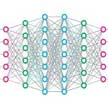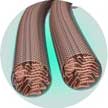Showing Spotlights 465 - 472 of 2777 in category All (newest first):
 Researchers exploited for the first time cellular self-recognition process for targeting glioblastoma cells with boron nitride nanotubes (BNNTs), a biocompatible, yet inorganic, nanomaterial.
The team loaded the BNNTs with doxorubicin, a powerful chemotherapy drug, and then functionalized them with glioblastoma cell membranes This targeting approach benefits from the ability of cancer cells to recognize each other due to similarities present on their membrane that make them different from healthy cells.
Researchers exploited for the first time cellular self-recognition process for targeting glioblastoma cells with boron nitride nanotubes (BNNTs), a biocompatible, yet inorganic, nanomaterial.
The team loaded the BNNTs with doxorubicin, a powerful chemotherapy drug, and then functionalized them with glioblastoma cell membranes This targeting approach benefits from the ability of cancer cells to recognize each other due to similarities present on their membrane that make them different from healthy cells.
May 11th, 2020
 Superconducting materials, which entirely lose their electrical resistance at low temperatures, have become ever more widespread over recent years. Nevertheless, the fascinating phenomenon of superconductivity does not cease to surprise, as the kinds of materials able to superconduct, as well as the mechanisms through which superconductivity emerges, have become increasingly diverse. One of the prime examples is found in the compound 2D material tantalum disulfide, where the critical temperature below which superconductivity appears increases multifold as the crystal is made thinner down to a monolayer.
Superconducting materials, which entirely lose their electrical resistance at low temperatures, have become ever more widespread over recent years. Nevertheless, the fascinating phenomenon of superconductivity does not cease to surprise, as the kinds of materials able to superconduct, as well as the mechanisms through which superconductivity emerges, have become increasingly diverse. One of the prime examples is found in the compound 2D material tantalum disulfide, where the critical temperature below which superconductivity appears increases multifold as the crystal is made thinner down to a monolayer.
May 8th, 2020
 Those of us who work in the field of nanoscience know all about the uniqueness of the nanoscale. However, now that use cases for nanotechnology are ramping up across virtually all industry sectors, it's essential to take a step back and remember that few in the business world have experience like ours. In fact, many in the C-suite may be unsure of what nanoscience is or how their businesses could benefit from it. That's a big problem - because these decision makers are not going to support nanotechnology projects that they don't fundamentally understand. We need to rise to the challenge and start helping business leaders appreciate the distinctiveness and enormous potential of this rapidly evolving field.
Those of us who work in the field of nanoscience know all about the uniqueness of the nanoscale. However, now that use cases for nanotechnology are ramping up across virtually all industry sectors, it's essential to take a step back and remember that few in the business world have experience like ours. In fact, many in the C-suite may be unsure of what nanoscience is or how their businesses could benefit from it. That's a big problem - because these decision makers are not going to support nanotechnology projects that they don't fundamentally understand. We need to rise to the challenge and start helping business leaders appreciate the distinctiveness and enormous potential of this rapidly evolving field.
May 7th, 2020
 The structure of individual molecules and their properties, such as chirality, are difficult to monitor in real time. It turns out that temporarily bridging molecules together can provide a lens into their dynamics. Scientists now have exposed new pathways for investigating biochemical reactions at the nanoscale. They found that optoplasmonic coupling allows for the detection of biomolecules that approach nanoparticles, while they attach, detach, and interact in a variety of ways. The technique paves the way for many future single-molecule analysis techniques that researchers have only been dreaming about.
The structure of individual molecules and their properties, such as chirality, are difficult to monitor in real time. It turns out that temporarily bridging molecules together can provide a lens into their dynamics. Scientists now have exposed new pathways for investigating biochemical reactions at the nanoscale. They found that optoplasmonic coupling allows for the detection of biomolecules that approach nanoparticles, while they attach, detach, and interact in a variety of ways. The technique paves the way for many future single-molecule analysis techniques that researchers have only been dreaming about.
May 6th, 2020
 Sintering is a critical processing technology in the production of ceramic materials that uses high heat to compact ceramic powders into a solid form. Sintering of pure oxide ceramics requires relatively long processing times (about 20 hours) and high temperatures of 800 degrees Celsius or more. Researchers have now developed an ultrafast high-temperature sintering technique to fabricate solid state electrolytes for solid state batteries with dense structure and excellent electrochemical performance.
Sintering is a critical processing technology in the production of ceramic materials that uses high heat to compact ceramic powders into a solid form. Sintering of pure oxide ceramics requires relatively long processing times (about 20 hours) and high temperatures of 800 degrees Celsius or more. Researchers have now developed an ultrafast high-temperature sintering technique to fabricate solid state electrolytes for solid state batteries with dense structure and excellent electrochemical performance.
May 4th, 2020
 Inspired by living organisms, researchers have developed a somatosensory light-driven robot (SLiR) that can simultaneously sense strain and temperature. The SLiR subsumes pyro/piezoelectric responses and piezoresistive strain sensation under a photoactuator transducer, enabling simultaneous yet non-interfering perception of its body temperature and actuation deformation states. This design confers soft robots with complex perceptions of their body status, as well as the surrounding environments.
Inspired by living organisms, researchers have developed a somatosensory light-driven robot (SLiR) that can simultaneously sense strain and temperature. The SLiR subsumes pyro/piezoelectric responses and piezoresistive strain sensation under a photoactuator transducer, enabling simultaneous yet non-interfering perception of its body temperature and actuation deformation states. This design confers soft robots with complex perceptions of their body status, as well as the surrounding environments.
Apr 28th, 2020
 Siloxanes - a class of manufactured silicone derivatives, also know as silicones - are widely used (with an annual volume of 2.8 million tonnes in 2018) in medicine and industrial applications, mostly though in cosmetics and personal care products. However, siloxanes can also be organic contaminants that are persistent and prone to bio accumulation, making it challenging to remove them from various environmental media. Developing suitable sorbents is a cost-effective solution for the removal of siloxanes and Machine Learning offers a powerful tool to identify the effective zeolites out of many millions.
Siloxanes - a class of manufactured silicone derivatives, also know as silicones - are widely used (with an annual volume of 2.8 million tonnes in 2018) in medicine and industrial applications, mostly though in cosmetics and personal care products. However, siloxanes can also be organic contaminants that are persistent and prone to bio accumulation, making it challenging to remove them from various environmental media. Developing suitable sorbents is a cost-effective solution for the removal of siloxanes and Machine Learning offers a powerful tool to identify the effective zeolites out of many millions.
Apr 21st, 2020
 Deep brain stimulation (DBS) is an effective treatment for many neurological disorders, but despite its widespread utilization the underlying mechanisms and downstream effects of DBS remain poorly understood. One major issue to understand the therapeutic mechanism of DBS is to map the wide variety of brain responses at both the local and global levels. Researchers have developed a highly MRI-compatible graphene fiber electrode that enables full activation pattern mapping by functional magnetic resonance imaging under DBS without the occurence of artifacts resulting from magnetic field interference.
Deep brain stimulation (DBS) is an effective treatment for many neurological disorders, but despite its widespread utilization the underlying mechanisms and downstream effects of DBS remain poorly understood. One major issue to understand the therapeutic mechanism of DBS is to map the wide variety of brain responses at both the local and global levels. Researchers have developed a highly MRI-compatible graphene fiber electrode that enables full activation pattern mapping by functional magnetic resonance imaging under DBS without the occurence of artifacts resulting from magnetic field interference.
Apr 20th, 2020
 Researchers exploited for the first time cellular self-recognition process for targeting glioblastoma cells with boron nitride nanotubes (BNNTs), a biocompatible, yet inorganic, nanomaterial.
The team loaded the BNNTs with doxorubicin, a powerful chemotherapy drug, and then functionalized them with glioblastoma cell membranes This targeting approach benefits from the ability of cancer cells to recognize each other due to similarities present on their membrane that make them different from healthy cells.
Researchers exploited for the first time cellular self-recognition process for targeting glioblastoma cells with boron nitride nanotubes (BNNTs), a biocompatible, yet inorganic, nanomaterial.
The team loaded the BNNTs with doxorubicin, a powerful chemotherapy drug, and then functionalized them with glioblastoma cell membranes This targeting approach benefits from the ability of cancer cells to recognize each other due to similarities present on their membrane that make them different from healthy cells. 
 Subscribe to our Nanotechnology Spotlight feed
Subscribe to our Nanotechnology Spotlight feed





